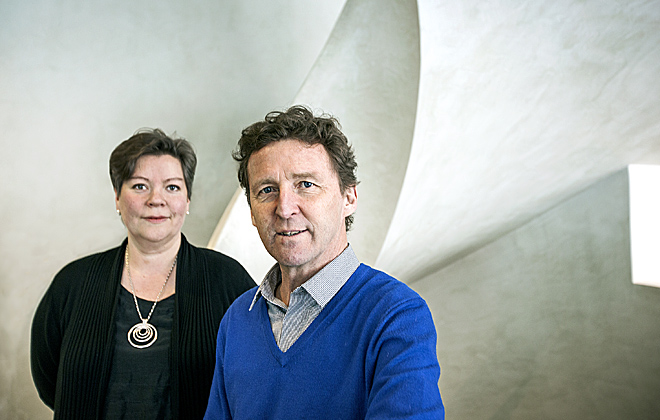KTH duo realizing vision for Russian tech centre
Education
They regularly shuttle between meetings in Boston and Moscow, and stay in constant contact with teams on both sides of the Atlantic; but the pay-off for Mats Hanson and Kristina Edström is seeing a new university take shape.

The pair from KTH play a key role in building Russia’s Skolkovo Institute of Science and Technology.
Hanson, the former Vice Dean of KTH’s the School of Education and Communication in Engineering Science, is on partial leave of absence from KTH and now has a home in Moscow. He and Edström, educational developer at KTH, were recruited to take responsibility for the development of education at “Skoltech”, a graduate research university which is being built as a part of Russia’s Centre for Entrepreneurship and Innovation (CEI) in the Moscow suburb of Skolkovo.
The project is a joint endeavour of the Skolkovo Foundation and Massachusetts Institute of Technology (MIT). Later in 2013, Skoltech will receive its first graduate students and PhD candidates, as well as researchers from around the world.
Hanson says the focus of Skoltech is on research, education, innovation and entrepreneurship.
“The idea is that Skoltech will become a bridge between cutting-edge research and the practical use of the results,” he says. “Building a new university over the course of a few years is very challenging; and one is humbled by the task.”
Recognition of KTH
Hanson and Edström say the opportunity to work internationally with education issues – as well as in the CDIO framework and the Bologna process – was a difficult one to turn down.
“It’s an irresistible opportunity to be able to build something from scratch, where you can more actively choose which traditions and patterns are useful,” Edström says.
She says that she and Hanson bring relevant experience from KTH, both in terms of creating new courses and developing pedagogy and organization. “And certainly it should be seen as a recognition of KTH’s educational development that we get to be here in this context,” Edström says.
Because everything is built from the ground up, Hanson and Edström discuss, reflect and decide on everything from the design of the learning environment, to which education programmes will be offered.
Skoltech’s master’s and doctoral programmes are structured around five specific sectors: energy, information technology, biomedical, aerospace, and nuclear engineering. In Russia, universities focus on undergraduate education, while research and research training are organised by the Academy of Sciences Institute.
At Skoltech, research and education are instead linked to cross-fertilize each other and lead to innovation.
“The university will attract top researchers from around the world. One way will be by attracting back successful Russian scientists who have moved abroad,” Hanson says.
The new interdisciplinary university is expected to have the latest equipment in the respective fields of research and thus become a magnet for both research groups and students.

“We hope that the international students will desire a top-class master’s education and thus be ready for the global labour market,” he says.
Sketches, models and structures for Skoltech grow at a furious pace. Pictures show a gigantic campus with long buildings that resemble space stations, plus apartments for 900 students. For now, these remain only on the drawing board; but in a few months the first batch of 70 students will get to work in rented premises. When the university is fully built, it will have 1,200 students, 200 professors and 300 scientists from around the world.
The sun never sets
Skoltech is the product of extensive collaboration with MIT, which is reflected in the international team that Hanson and Edström are part of. Each month the two commute between Boston and Moscow, and spend hours communicating via Skype with other team members.
With a time difference of nine hours between Moscow and Boston, “the sun literally never sets on this project,” Hanson says. The duo pull long hours when they return to Stockholm, because when the Russians turn in for the night, the Americans are just waking up – and vice versa.
But the differences between the U.S. and Russia extend beyond time and distance. Edström says that it can be delicate making decisions and finding optimal solutions in such an international working group.
“There are many different systems that have been in place so long, you have to dare to wipe the slate clean and think flexibly. You have to dare look at both intended and unintended consequences,” Edström says.
“I think we bring a kind of Swedish neutrality, which is good for the project,” Hanson says. “There is rarely a single right way, but things can be solved in many different ways. You must be able to see the best in the different worlds.”
Jill Klackenberg
Skoltech in brief:
Skolkovo Institute of Science and Technology is located in the suburb of Skolkovo, about 20 km from central Moscow. The university and research centre was started under a directive from former President Dmitry Medvedev to modernise and diversify the Russian economy, and to increase international knowledge exchange.
The campus is situated in the heart of Skolkovo Innovation Centre, a newly-established ecosystem of corporate R&D centres, business incubators and accelerators, private seed and venture funds, and start-up companies, as well as residential space and social infrastructure. Skokolvo City has five clusters, which mirror the university's five research areas: energy, information technology, biomedical, aerospace, and nuclear engineering.